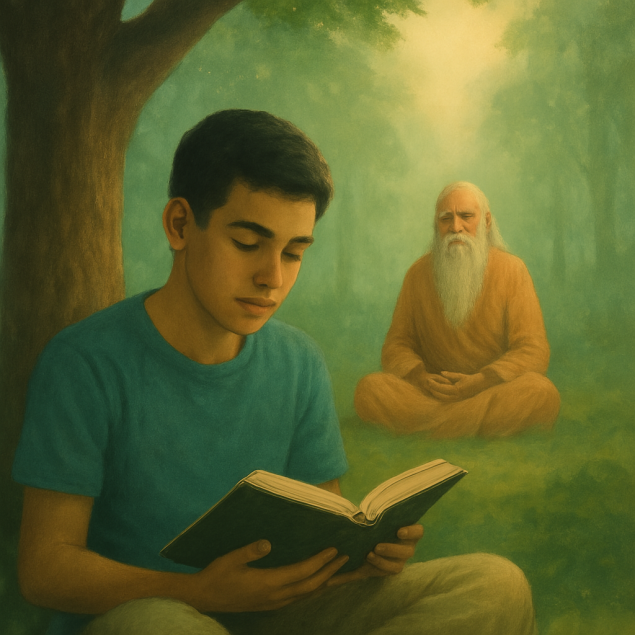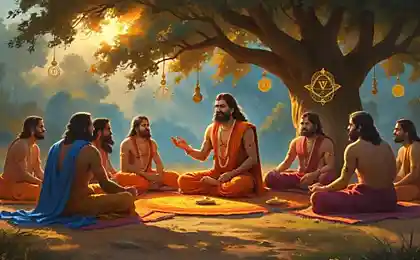154
Stages of Life by Age: Hindu Wisdom on Purpose in Different Periods of Life

In a world where time seems like an inexorable stream, we often wonder how to live life in a way that makes sense. The ancient Hindus, whose philosophy has stood the test for thousands of years, offer the answer through the concept of the ashram, the four stages of life. Each of them is not just an age period, but an opportunity to reveal your potential, find harmony and leave a mark on the world. This wisdom, born on the banks of the Ganges, is remarkably consonant with modernity, helping us to understand what to devote ourselves to in different years.
The Hindu Concept of the Ashram: Life as a Journey
Hinduism regards life as a sequence of four ashrams, each lasting approximately a quarter of a century. It is not a strict framework, but a guide that helps a person move from youth to maturity and then to spiritual depth. Let’s take a look at each stage and learn how to apply this philosophy today.
Brahmacharya: A Time of Discipleship and Growth
Before the age of 25, life is a school where we learn from the world and ourselves. In ancient India, young men went to the guru to learn sacred texts and crafts. Imagine a young man sitting under a banyan tree, absorbing the knowledge of the universe. Today is a time of learning, experimenting and finding yourself.

Council: Don't be afraid to try new things. This is a time when mistakes are your best teachers. Sign up for a course you’ve long dreamed of, or take a trip to broaden your horizons.
- Invest in education: formal or self-study.
- Develop discipline through sports or meditation.
- Look for mentors whose experience inspires you.
Remember Steve Jobs, who in his youth studied calligraphy – a skill that seemed useless, but later determined the aesthetics of Apple. It's a brahmacharya in action.
Grihastha: The Age of Family and Achievement
From the age of 25 to 50, a person enters Grihastha, a time when we build a family, a career and contribute to society. It is the heart of life, full of passion and responsibility. Imagine a father teaching his son to fish, or a woman starting a business from scratch.
Lifehack: Find a balance between work and personal life. Set up an evening ritual - an hour without gadgets with loved ones to strengthen the bond.
- Set ambitious goals in your career and finances.
- Start a family or support a community.
- Share success: Help those who are less fortunate.
Example: In India, there is still a tradition of adult children taking care of their parents, showing how the grihastha brings generations together.
Vanaprastha: Time for Retreat and Wisdom
From the ages of 50 to 75, vanaprastha begins, a time when we step away from the hustle and look inward. In ancient times it was a retreat to the forest for thought, but today it can be a transfer of affairs and a search for depth. Think of a grandmother who teaches grandchildren how to bake bread by sharing stories from the past.
Recommendation: Start a journal or do yoga. This will help to reflect on the past and prepare for the next stage.
- Transmit knowledge through mentoring or books.
- Do charity by sharing what you have.
- Explore spirituality: Meditation or reading philosophical texts.
Sanyasa: The Final Renunciation and Enlightenment
After 75 years comes sannyasa - the time of giving up material for the sake of the spiritual. This is not the end, but the culmination of the journey. Imagine an old man sitting on a hilltop, surrounded by silence and stars, at peace with himself and the world.

Council: Let go of old grievances. Forgive yourself and others for inner freedom.
- Focus on simplicity: fewer things, more meaning.
- Share your wisdom with younger generations.
- Practice mindfulness through breathing exercises.
How to Apply Ashrams Today?
Modern life is different from ancient India, but the principles of the ashram are universal. They teach us to plan our lives, find balance, and accept change. For example, in your 30s, you can have a career (grihastha) but already learn meditation (vanaprastha) in preparation for the future.
Practice: Make a list of priorities for your current life. Update it every five years to stay in tune with yourself.
History: Swami Vivekananda once said, “Take one idea, make it your life.” It’s a reminder that each stage is a chance to delve deeper into what matters to you.
Conclusion: Life as Art
The wisdom of Hindus about the stages of life is not just a philosophy, but a practical guide. It reminds us that life is not a chaotic run, but an art where every period has a purpose. By applying these principles, we can not only find inner peace, but also inspire others with our example. Start small: identify where you are now, and ask yourself the question – what do I want to dedicate myself to?
Read more about Hindu philosophy in Wikipedia or the books of Swami Sivananda.
Glossary
- Ashram: The stage of life in Hinduism; also a place of spiritual solitude.
- Brahmacharya: The first stage is about learning and self-discipline.
- Grihastha: The second stage is related to family life and debt.
- Vanaprastha: The third stage is the time of transition from worldly affairs to spirituality.
- Sanyasa: The fourth stage, the period of renunciation and desire for moksha.
- Moksha: Liberation from the cycle of rebirth is the highest goal in Hinduism.
9 Habits That Are Seriously Harming Your Teeth
What's your attitude to life? Victim, Child, Wrestler, Player or Author?























